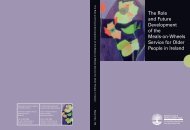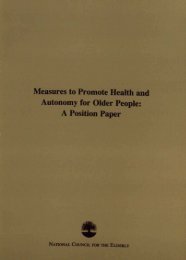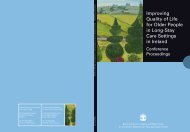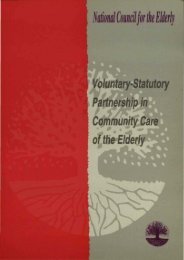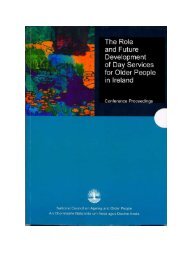From Ageism to Age Equality: Addressing the Challenges ...
From Ageism to Age Equality: Addressing the Challenges ...
From Ageism to Age Equality: Addressing the Challenges ...
Create successful ePaper yourself
Turn your PDF publications into a flip-book with our unique Google optimized e-Paper software.
To do this effectively requires adequate resources. It is important that we work <strong>to</strong>ge<strong>the</strong>r <strong>to</strong> secure<strong>the</strong>se resources and advance community advocacy as a source of support for older people. It is key<strong>to</strong> <strong>the</strong> effectiveness and potential of <strong>the</strong> legislation. It does, however, pose new challenges forcommunity organisations and demands innovation and creativity. It could, <strong>the</strong>refore, usefully providea focus for fur<strong>the</strong>r debate.Institutional Practice<strong>Equality</strong> legislation is an important starting point in challenging ageism. To accompany it, employersand service providers need <strong>to</strong> change <strong>the</strong>ir practice. This change should involve more planned andsystematic approaches <strong>to</strong> equality with a more proactive approach <strong>to</strong> including an equality focus indecision-making, policy development and programme design.Planned and systematic approaches <strong>to</strong> equality ensure an equality dimension within all <strong>the</strong> systems,policies, procedures and practices of an organisation. <strong>Equality</strong> should be mainstreamed or integrated in<strong>to</strong><strong>the</strong> human resource, cus<strong>to</strong>mer service and business planning functions. This mainstreaming orintegration should be built on an equality infrastructure. This infrastructure should consist of five ‘pillars’:equality policies that focus on older people and establish <strong>the</strong> organisation’s commitment <strong>to</strong>combating discrimination and promoting equality for older people as employees and cus<strong>to</strong>mersequality and diversity training that builds awareness among staff about ageism and how <strong>to</strong>combat it, and that develops skills among key staff <strong>to</strong> effectively manage age diversity andpromote equalityequality plans that establish equality objectives for <strong>the</strong> organisation and <strong>the</strong> steps required <strong>to</strong>meet <strong>the</strong>se. (Plans should take advantage of <strong>the</strong> new ‘positive action’ provisions of <strong>the</strong>Employment <strong>Equality</strong> Acts that allow <strong>the</strong> pursuit of full equality in practice for older people; <strong>the</strong>yshould be evidence-based, developed on foot of a review of <strong>the</strong> experience and situation of olderpeople as employees and cus<strong>to</strong>mers and a review of institutional policies, practices andprocedures)65a designated staff member or wider committee responsible for advancing equality objectiveswithin <strong>the</strong> organisationfora or meetings that allow for a dialogue between <strong>the</strong> organisation and older employees andcus<strong>to</strong>mers about <strong>the</strong>ir specific needs and how best <strong>to</strong> meet <strong>the</strong>se.<strong>Equality</strong> Proofing and <strong>Age</strong> ProofingThis planned and systematic approach <strong>to</strong> equality, encompassing strategies <strong>to</strong> build an equality focusin<strong>to</strong> decision-making, policy development and programme design, should focus on all nine groundscovered by <strong>the</strong> equality legislation alongside this specific focus on older people. This is known asequality proofing and age proofing should sit within this.<strong>Age</strong> proofing involves testing out new policies, new programmes or important decisions for <strong>the</strong>irimpact on older people and for <strong>the</strong>ir capacity <strong>to</strong> achieve equality for older people. To do this involves:ga<strong>the</strong>ring relevant data on <strong>the</strong> experience and situation of older peopletalking <strong>to</strong> older people and <strong>the</strong>ir organisations about <strong>the</strong> issues concernedassessing <strong>the</strong> capacity of <strong>the</strong> decision, policy or programme <strong>to</strong> take account of age diversity andidentifying any changes that are required <strong>to</strong> ensure a positive impact on older people.<strong>From</strong> <strong><strong>Age</strong>ism</strong> <strong>to</strong> <strong>Age</strong> <strong>Equality</strong>: <strong>Addressing</strong> <strong>the</strong> <strong>Challenges</strong>








